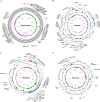The Klebsiella pneumoniae tellurium resistance gene terC contributes to both tellurite and zinc resistance
- PMID: 40202338
- PMCID: PMC12054061
- DOI: 10.1128/spectrum.02634-24
The Klebsiella pneumoniae tellurium resistance gene terC contributes to both tellurite and zinc resistance
Abstract
Klebsiella pneumoniae is widely recognized as a pathogen responsible for hospital-acquired infections and community-acquired invasive infections. It has rapidly become a significant global public health threat due to the emergence of hypervirulent and multidrug-resistant strains, which have increased the challenges associated with treating life-threatening infections. Tellurium resistance genes are widespread on virulence plasmids in K. pneumoniae isolates. However, the core function of the ter operon (terZABCDEF) in K. pneumoniae remains unclear. In this study, the multidrug-resistant K. pneumoniae P1927 strain was isolated from the sputum of a hospitalized pneumonia patient. The ter operon, along with antimicrobial resistance and virulence genes, was identified on a large hybrid plasmid in K. pneumoniae P1927. We generated a terC deletion mutant and demonstrated that this mutant exhibited reduced virulence in a Galleria mellonella larva infection model. Further physiological functional analysis revealed that terC is not only important for Te(IV) resistance but also for resistance to Zn(II), Mn(II), and phage infection. All genes of the ter operon were highly inducible by Zn(II), which is a stronger inducer than Te(IV), and the terBCDE genes were also induced by Mn(II). Collectively, our study demonstrates novel physiological functions of TerC in Zn(II) resistance and virulence in K. pneumoniae.IMPORTANCEKlebsiella pneumoniae has rapidly become a global threat to public health. Although the ter operon is widely identified in clinical isolates, its physiological function remains unclear. It has been proposed that proteins encoded by the ter operon form a multi-site metal-binding complex, but its exact function is still unknown. TerC, a central component of the tellurium resistance determinant, was previously shown to interact with outer membrane proteins OmpA and KpsD in Escherichia coli, suggesting potential changes in outer membrane structure and properties. Here, we report that TerC confers resistance to Zn(II), Mn(II), and phage infection, and Zn(II) was shown to be a strong inducer of the ter operon. Furthermore, TerC was identified as a novel virulence factor. Taken together, our results expand our understanding of the physiological functions encoded by the ter operon and its role in the virulence of K. pneumoniae, providing deeper insights into the link between heavy metal(loid) resistance determinants and virulence in pathogenic bacteria.
Keywords: Klebsiella pneumoniae; TerC; virulence; zinc detoxification.
Conflict of interest statement
The authors declare no conflict of interest.
Figures








Similar articles
-
Co-Occurrence of Rare ArmA-, RmtB-, and KPC-2-Encoding Multidrug-Resistant Plasmids and Hypervirulence iuc Operon in ST11-KL47 Klebsiella pneumoniae.Microbiol Spectr. 2022 Apr 27;10(2):e0237121. doi: 10.1128/spectrum.02371-21. Epub 2022 Mar 24. Microbiol Spectr. 2022. PMID: 35323034 Free PMC article.
-
The Klebsiella pneumoniae ter Operon Enhances Stress Tolerance.Infect Immun. 2023 Feb 16;91(2):e0055922. doi: 10.1128/iai.00559-22. Epub 2023 Jan 18. Infect Immun. 2023. PMID: 36651775 Free PMC article.
-
An inducible tellurite-resistance operon in Proteus mirabilis.Microbiology (Reading). 2003 May;149(Pt 5):1285-1295. doi: 10.1099/mic.0.25981-0. Microbiology (Reading). 2003. PMID: 12724390
-
Antimicrobial Resistance of Hypervirulent Klebsiella pneumoniae: Epidemiology, Hypervirulence-Associated Determinants, and Resistance Mechanisms.Front Cell Infect Microbiol. 2017 Nov 21;7:483. doi: 10.3389/fcimb.2017.00483. eCollection 2017. Front Cell Infect Microbiol. 2017. PMID: 29209595 Free PMC article. Review.
-
Hypervirulent and carbapenem-resistant Klebsiella pneumoniae: A global public health threat.Microbiol Res. 2024 Nov;288:127839. doi: 10.1016/j.micres.2024.127839. Epub 2024 Aug 11. Microbiol Res. 2024. PMID: 39141971 Review.
References
-
- Turton JF, Payne Z, Coward A, Hopkins KL, Turton JA, Doumith M, Woodford N. 2018. Virulence genes in isolates of Klebsiella pneumoniae from the UK during 2016, including among carbapenemase gene-positive hypervirulent K1-ST23 and “non-hypervirulent” types ST147, ST15 and ST383. J Med Microbiol 67:118–128. doi:10.1099/jmm.0.000653 - DOI - PubMed
Grants and funding
LinkOut - more resources
Full Text Sources

